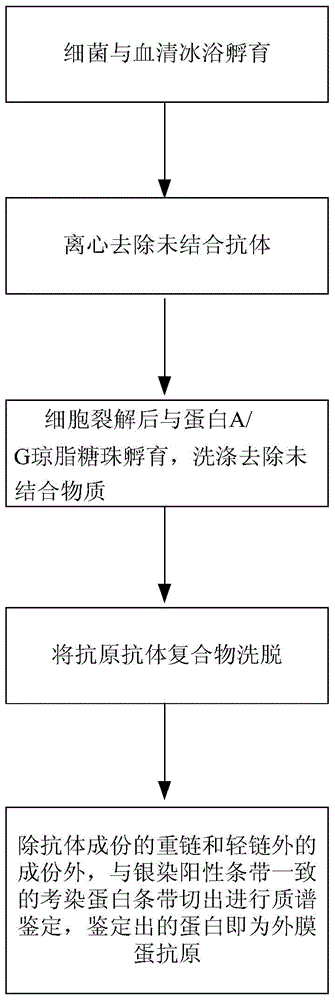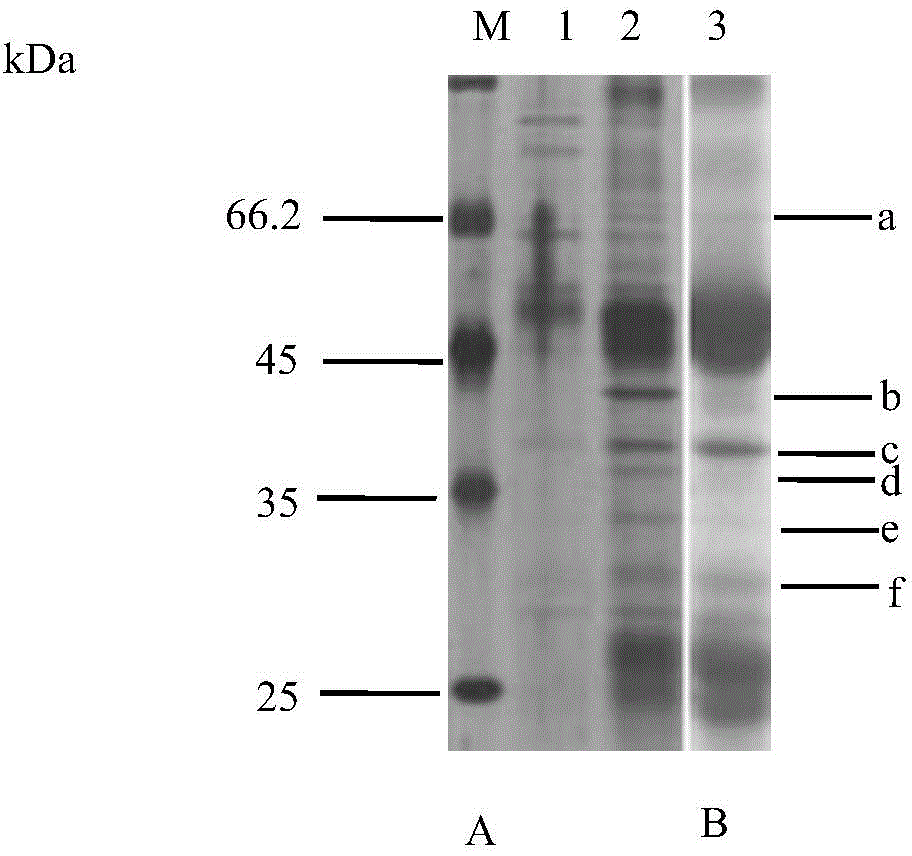Method for screening and identifying microbial cell surface antigen
A technology of microbial cells and surface antigens, applied in biological testing, material testing products, measuring devices, etc., can solve the problems of outer membrane protein difficulty, limited application, poor repeatability, etc., and achieve simple and fast operation steps, improve efficiency, and simplify experiments. effect of steps
- Summary
- Abstract
- Description
- Claims
- Application Information
AI Technical Summary
Problems solved by technology
Method used
Image
Examples
Embodiment 1
[0021] 1. Bacterial culture, counting and collection: Vibrio parahaemolyticus VPL4-90 was used as the microorganism to preserve the strains in this laboratory. VPL4-90 was inoculated in LB medium and cultured on a shaker at 28°C for 18h. After the cultivation, 2 mL of the bacterial liquid was taken to count the colonies on the plate. The rest of the culture solution was centrifuged at 5000rpm for 10min to collect the bacterial cells, and the bacterial cells were washed 3 times with physiological saline. Adjust its concentration to 10 with normal saline 9 CFU / mL.
[0022] 2. Preparation of anti-pathogen antiserum: add 0.025% formaldehyde by volume fraction to the prepared VPL4-90 cell suspension, act at 30°C for 4 hours to make inactivated pathogens, rotate at 5000rpm for 10min, wash with normal saline three times, and finally Then adjust its concentration to 10 with normal saline 9 CFU / mL, inject New Zealand white rabbits, each 1mL, inject normal saline in the control grou...
Embodiment 2
[0028] Example 2 was the same as Example 1, except that the bacteria were changed to Vibrio mimeticus ATCC33653 and Qing was added at a volume ratio of 1:250. The result is as follows
[0029] 1. The SDS-PAGE pattern of the immunoprecipitated cell surface proteins of Vibrio mimeticus. In the stained electrophoresis gel, there are 6 protein bands consistent with the silver-stained positive bands, numbered a~h respectively. The results of silver staining observation and staining mass spectrometry of Vibrio mimicus immunoprecipitation complex are shown in figure 2 -A and 2-B.
[0030] 2. The mass spectrometric identification results of the 6 protein bands are shown in Table 2. 8 proteins were identified by the 6 protein bands, 4 of which are outer membrane protein antigens on the cell surface of Vibrio mimicus, and 2 are inner membrane proteins of Vibrio mimicus. Membrane protein antigens, one is a protein translation-related factor that may be located on the surface of Vibrio...
PUM
 Login to View More
Login to View More Abstract
Description
Claims
Application Information
 Login to View More
Login to View More - R&D
- Intellectual Property
- Life Sciences
- Materials
- Tech Scout
- Unparalleled Data Quality
- Higher Quality Content
- 60% Fewer Hallucinations
Browse by: Latest US Patents, China's latest patents, Technical Efficacy Thesaurus, Application Domain, Technology Topic, Popular Technical Reports.
© 2025 PatSnap. All rights reserved.Legal|Privacy policy|Modern Slavery Act Transparency Statement|Sitemap|About US| Contact US: help@patsnap.com



